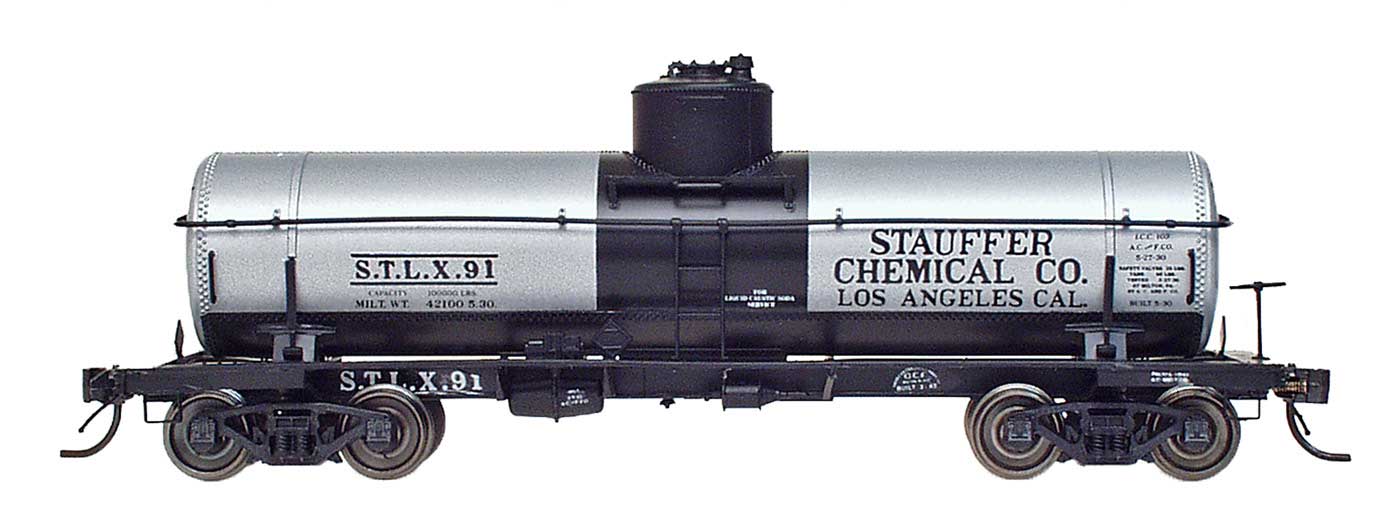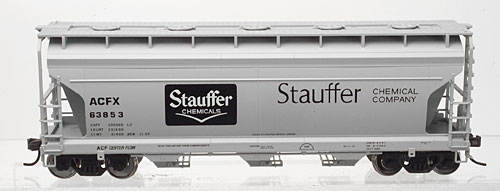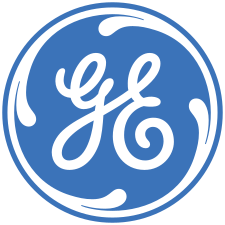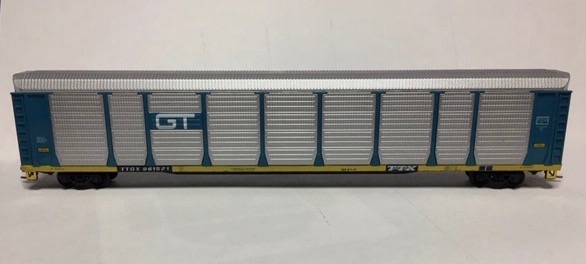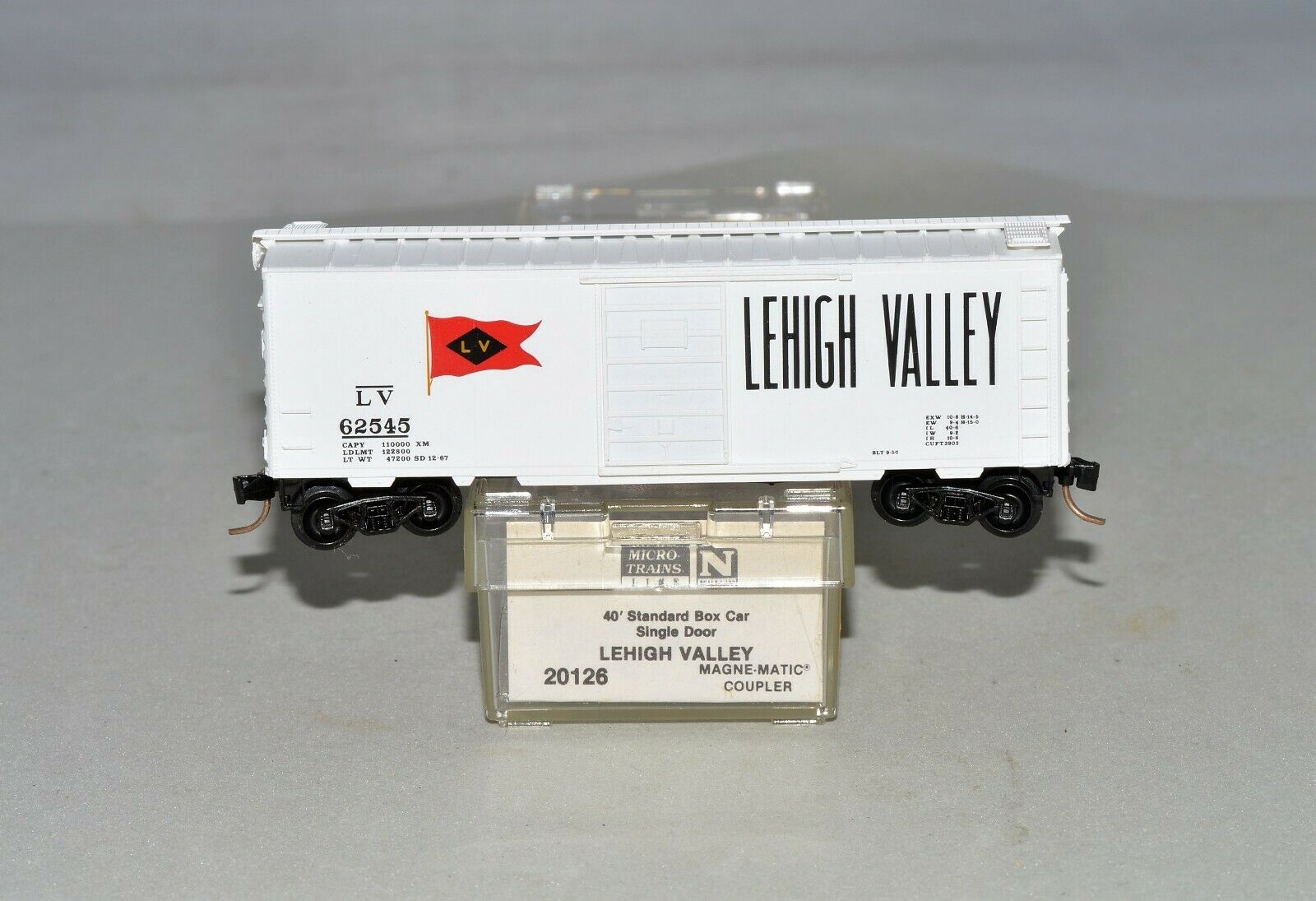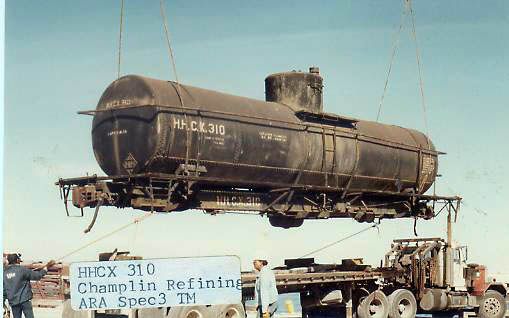Specific Item Information: Tested: 4-37
Model Information: This popular InterMountain model comes in both kit and RTR (Read-to-Run) versions. Different couplers have been used over the years. Recent (2010+) versions have generic magnetic operating couplers.
Prototype History: The ACF® 8,000 Gallon Type 27 Tank Car was one of the most popular standard design riveted tank cars of the first half of the twentieth century. ACF® built more than 1,800 of these cars for a wide variety of customers in the petroleum, chemical, and food industries. Virtually every bulk liquid or gas of the era was shipped in these cars (and its similar 10,000 gallon brother). Typical products included petroleum, acids, alcohol, propane, ammonia, molasses and vegetable oil.
Specifications: Underframe general design: 2 – 13" channel center sills with riveted top plate, 4 – 7" channel side sills (bolsters to end sills), 2 – 9" channel end sills to form the structure. Underframe width of 9'-3" for cars 10,000 gal. or smaller. Wood running boards (1 ⅞" x 11¾" wide) and side dome platforms (often 1 ⅞ " x 7½" wide x 4' or longer). Standard underframe lengths (some changed over time). Standard tank designs with 3 courses, 2 courses for small capacity cars. Standard tank diameters and lengths for common sizes (6,000 to 10,000 gallon @ 1,000 gallon increments). Hand rails 1 ¼" O.D. pipe. 30" diameter domes on most 103A/103B acid cars.
Specifications: Underframe general design: 2 – 13" channel center sills with riveted top plate, 4 – 7" channel side sills (bolsters to end sills), 2 – 9" channel end sills to form the structure. Underframe width of 9'-3" for cars 10,000 gal. or smaller. Wood running boards (1 ⅞" x 11¾" wide) and side dome platforms (often 1 ⅞ " x 7½" wide x 4' or longer). Standard underframe lengths (some changed over time). Standard tank designs with 3 courses, 2 courses for small capacity cars. Standard tank diameters and lengths for common sizes (6,000 to 10,000 gallon @ 1,000 gallon increments). Hand rails 1 ¼" O.D. pipe. 30" diameter domes on most 103A/103B acid cars.
Road Name History: 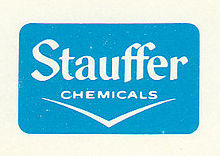 Stauffer Chemical Company is a former American chemical company which manufactured herbicides for corn and rice. It was acquired by Imperial Chemical Industries from Chesebrough-Pond's Inc. in 1987. In 1987, Stauffer's head office was in Westport, Connecticut. Late that year, Imperial sold Stauffer's basic chemicals business to Rh?ne-Poulenc S.A.
Stauffer Chemical Company is a former American chemical company which manufactured herbicides for corn and rice. It was acquired by Imperial Chemical Industries from Chesebrough-Pond's Inc. in 1987. In 1987, Stauffer's head office was in Westport, Connecticut. Late that year, Imperial sold Stauffer's basic chemicals business to Rh?ne-Poulenc S.A.
The company was founded in 1886 in San Francisco as a partnership between two young Europeans; a German, John Stauffer, Sr., and a Frenchman, Christian de Guigne. Ships exporting borax to Europe used sulfur as ballast. This ballast/sulfur became the inexpensive raw material for the newly formed company. The company was incorporated by John Stauffer, Sr., who died on March 4, 1940 at the age of 78.
In 1931, the company announced plans for a new manufacturing subsidiary, the Pacific Hard Rubber Company. Hans Stauffer, nephew of founder John Stauffer, Sr, who joined his uncle at Stauffer Chemicals in 1920 and who retired as president in 1967, died in 1986.
John Stauffer Jr., director emeritus of the company and son of the company's founder, died in 1972. The John Stauffer Laboratory for Physical Chemistry, the John Stauffer Chemistry Building at Stanford University, and the John Stauffer Science Center at Whittier College are all named after him.

The company was founded in 1886 in San Francisco as a partnership between two young Europeans; a German, John Stauffer, Sr., and a Frenchman, Christian de Guigne. Ships exporting borax to Europe used sulfur as ballast. This ballast/sulfur became the inexpensive raw material for the newly formed company. The company was incorporated by John Stauffer, Sr., who died on March 4, 1940 at the age of 78.
In 1931, the company announced plans for a new manufacturing subsidiary, the Pacific Hard Rubber Company. Hans Stauffer, nephew of founder John Stauffer, Sr, who joined his uncle at Stauffer Chemicals in 1920 and who retired as president in 1967, died in 1986.
John Stauffer Jr., director emeritus of the company and son of the company's founder, died in 1972. The John Stauffer Laboratory for Physical Chemistry, the John Stauffer Chemistry Building at Stanford University, and the John Stauffer Science Center at Whittier College are all named after him.
Brand/Importer Information: InterMountain was founded in 1985 by Fred Brummet. They got started in the model railroad business by producing O-Scale model kits. They got started in the N Scale business almost a decade later when in 1994 they introduced the 40-23 reefer car in kit form. Later, in 1998, they started producing RTR (Ready-to-Run) models. By the early 2000s, InterMountain phased out kit production in favor of the RTR models.
The InterMountain Railway company is located at 1224 Boston Ave in Longmont, CO. They are a manufacturer of HO, N and Z scale model trains. They have produced kits as well as RTR (Ready-To-Run) models. Their N Scale products include locomotives as well as rolling stock. Their rolling stock lineup includes Boxcars, Hoppers, Tank Cars, Reefers, Gondolas, Stock Cars and Flatcars.
Their locomotive releases have primarily been diesel units, with the one major exception being their series of AC-12 Cab Forward steam locos. Their diesel lineup includes F3's, F7's, F9's, SD40's, SD45's and FT units. They are known for quality and detail. They also release their rolling stock in larger varieties of road numbers than most of the other manufacturers.
The InterMountain Railway company is located at 1224 Boston Ave in Longmont, CO. They are a manufacturer of HO, N and Z scale model trains. They have produced kits as well as RTR (Ready-To-Run) models. Their N Scale products include locomotives as well as rolling stock. Their rolling stock lineup includes Boxcars, Hoppers, Tank Cars, Reefers, Gondolas, Stock Cars and Flatcars.
Their locomotive releases have primarily been diesel units, with the one major exception being their series of AC-12 Cab Forward steam locos. Their diesel lineup includes F3's, F7's, F9's, SD40's, SD45's and FT units. They are known for quality and detail. They also release their rolling stock in larger varieties of road numbers than most of the other manufacturers.
Item created by: petecduffy on 2019-03-26 11:30:13
If you see errors or missing data in this entry, please feel free to log in and edit it. Anyone with a Gmail account can log in instantly.
If you see errors or missing data in this entry, please feel free to log in and edit it. Anyone with a Gmail account can log in instantly.


